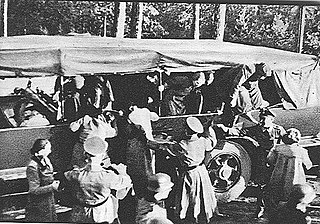You can help expand this article with text translated from the corresponding article in Polish. (December 2021) Click [show] for important translation instructions.
|
| AB-Aktion | |
|---|---|
 A picture taken from a nearby house by the Polish Underground of the Nazi Secret Police dislodging condemned victims from the Polish intelligentsia at the Palmiry forest execution site near Warsaw in 1940 | |
| Also known as | German: Außerordentliche Befriedungsaktion |
| Location | Palmiry Forest and similar locations in occupied Poland |
| Date | Spring–summer 1940 |
| Incident type | Mass murder with automatic weapons |
| Perpetrators | Wehrmacht, Einsatzgruppen |
| Participants | |
| Organizations | Waffen-SS, Schutzstaffel, Order Police battalions, Sicherheitsdienst |
| Victims | 7,000 intellectuals and leaders of the Second Polish Republic |
| Documentation | Pawiak and Gestapo |
| Memorials | Murder site and deportation points |
| Notes | Lethal phase of the invasion of Poland |
The 1940 AB-Aktion (German: Außerordentliche Befriedungsaktion, lit. 'Extraordinary Operation of Pacification'), a second stage of the Nazi German campaign of violence in Poland during World War II, aimed to eliminate the intellectuals and the upper classes of the Second Polish Republic across the territories slated for eventual annexation by the German Reich.
Most of the killings were arranged in a form of forced disappearances from multiple cities and towns upon the arrival of German forces.[1] In the spring and summer of 1940 the Nazi authorities in German-occupied central Poland (the so-called General Government) arrested more than 30,000 Polish citizens.[2] About 7,000 of them, including community leaders, professors, teachers and priests (labeled as suspected of criminal activities), were subsequently massacred secretly at various locations - including at the Palmiry forest complex near Palmiry.[3][4] The others were sent to Nazi concentration camps.
- ^ Piotrowski, Tadeusz (1998). Poland's Holocaust: ethnic strife, collaboration with occupying forces and genocide in the Second Republic, 1918-1947. McFarland. p. 25. ISBN 0786403713.
- ^ Chapter "Hitler's Plans for Poland." Noakes and Pridham, Nazism: A History in Documents Archived 2013-10-15 at the Wayback Machine, p. 988.
- ^ AB-Aktion, Shoah Resource Center, The International School for Holocaust Studies.
- ^ "Poles: Victims of the Nazi Era" at the "United States Holocaust Memorial Museum". Archived from the original on June 7, 2007. Retrieved 2013-05-24.